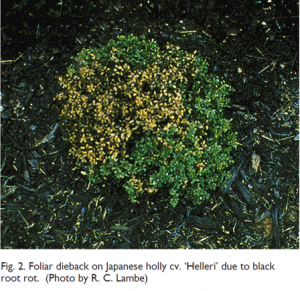Japanese holly, Ilex crenata, are popular evergreen shrubs found in many residential and commercial landscapes. Unlike many other types of hollies, Japanese hollies do not have any thorns. Some of the more popular varieties include ‘Helleri’, ‘Compacta’, and ‘Soft Touch’.
These slow-growing Japanese holly varieties produce dense, compact shrubs that require minimal pruning to maintain their shape or size. However, they do respond well to pruning and you will often find these used to make topiaries similar to boxwoods. In fact, some varieties look so much like boxwoods, that most clients often can’t tell the difference. The main difference is that boxwoods have an opposite leaf arrangement and hollies have an alternate leaf arrangement.
We have been receiving many calls about Japanese hollies declining over the last several years. It is likely that the weather extremes we’ve had in recent years are a major stress factor, which predisposes them to disease issues. Japanese hollies are better adapted to more northern zones 5 to 6 and, in my opinion, probably should not be planted in the deep South in zones 8 to 9. They just don’t handle heat or drought stress very well. They will persist better in this part of Georgia (zone 7) if they are planted in partial shade.

We often find canker diseases such as Phomopsis and Botryosphaeria involved with more severe twig and stem dieback on Japanese hollies. If this is the case, there are no fungicides that can be sprayed to cure a canker disease. The only option is to prune out the diseased branches to limit the spread of the disease.
Late winter and early spring are the best time to prune hollies back to rejuvenate. If the roots are still healthy, they can regenerate and produce new branches this summer. For appearances, it may be best to cut the entire shrub back to the same height to create a uniform look. If you already have severe dieback in the shrub, I would recommend this method and see how they respond. If they do not bounce back by the fall, then you should consider replacing them. Fall is the best time to plant new shrubs, which gives you time to decide if they are going to recover.
The same is true as far as root rot diseases such as Thielaviopsis and Phytophthora, in that, there are not any effective fungicide treatments for hollies that are already infected. Removal is usually recommended for root rot diseases. Check to make sure there are not any drainage issues associated with gutters and downspouts.
The symptoms and progression of dieback are very similar for each of these holly diseases. Treatment with fungicides is generally not very effective for managing these diseases and the strategies for prevention are all the same (an official diagnosis is not really necessary). Ultimately, the underlying cause of these diseases goes back to one of these environmental stresses: drought (2016 and 2019), soil compaction, poor drainage, frequent irrigation or too much rain (2018 and 2020). If you find holly decline to be a recurring issue in a particular landscape setting, then the best option may be to replace the plants with a different shrub species that is better adapted to these environmental issues.
